
Vsemirny_doklad_o_torgovle_lyudmi_2015
.pdf
Global overview
in the Middle East and in Western Europe. The local confraternity cells are involved in different criminal activities wherever they operate. This includes trafficking in persons for the purpose of sexual exploitation, drug trafficking, counterfeiting, documents falsification and money-laundering. They maintain a rigid hierarchical structure headed by a directorate and each forum is independent. The members have a specific functional and hierarchical role; they are connected by familiar or other relational ties. They have defined rules, initiation rituals and hundreds of members operating in Africa and on or in other continents. They use a combination of money collectors, cash mules and corruption to launder and transfer illegal profits from Europe to West Africa.v
As far as these confraternities’ involvement in the human trafficking activity is concerned, it appears that the role may change according to the different organizational capabilities of the local forum. In some cases the local forum does not directly engage in the recruitment, transportation and exploitation of victims, but rather ‘taxed’ and supervised the madam-driven networks that operate independently but within the territory under the confraternity’s control. In some other cases, the confraternities are directly managing the recruitment, transfer and exploitation of the victims. They also applied a ‘taxation’ to free prostitutes who want to operate in the areas under their control.v
Whether or not they do operate the human trafficking directly, the confraternities may facilitate it when they have some leverage to exert. For instance, investigative evidence shows that the confraternities are able to bribe officers in some European airports to facilitate the transit of victims into the European Union free movement area. These groups access institutions in Africa and Europe in order to secure travel documents and impunity. They use systematic corruption and violence to protect and expand their profits from the trafficking.v
On the basis of the evidence collected by the investigators, it is clear that the confraternities play an important role in interfacing with other criminal organizations that operate in the same territory, either peacefully or violently. For instance, in Italy, the members of the Eiye arrested were in business with a group from the Balkans for the distribution
of marijuana in the area under confraternity control. v
The Spanish investigators define the trafficking in persons originating from Nigeria as having a serious incidence in Spain (in 2013, 13 per cent of the victims detected and 8 per cent of the suspects arrested in Spain were Nigerian citizens). Some investigators suspect most of the Nigerian groups operating this trafficking operate under the control of the confraternities. v
The endurance of this trafficking flow in almost all Western European countries indicate this maybe the case also in other countries of the continent, although further investigative work would be needed to verify this.
IThe primary information for this text box was collected from law enforcement officers specialized on trafficking in persons and organized crime in Italy and Spain. The information concerning Spain was gathered from intelligence reports received from the national authorities of the Centro de Inteligencia Contra el Crimen Organizado (CICO), the Fuerzas y Cuerpos de Seguridad del Estado (Guardia Civil y el Cuerpo Nacional de Policia), and from the Mossos d’Esquadra for what concerns specifically the Autonomous Community of Catalonia in Spain. In Italy, the information was extrapolated from investigative files provided by the Procura Distrettuale Anti Mafia on the operation CULTS, completed in March 2014.
IIPrimary information collected for this study as indicated in note I. See also Carling, J., Migration, Human Smuggling and Trafficking from Nigeria to Europe, International Organization for Migration (IOM), 2005; Carchedi, F. and Orfano, I., La Tratta di Persone in Italia; Evoluzione del Fenomeno ed Ambiti di Sfruttamento, Osservatorio Tratta, FrancoAngeli, Milano, 2007; UNICRI, Trafficking of Nigerian Girls to Italy - the data, the stories, the social services, 2010.
IIIJuju is a traditional religious belief of the Yoruba people of Southwest Nigeria on the spirit world affecting the everyday life and it is predominantly practiced is in the Edo state and the River Niger Delta region. Juju was originally created by the early Europeans and it has its origins in the French word joujou, meaning toy or plaything. Juju refers to a small object that is believed to contain energy that brings luck and protection. The early Europeans mistakenly understood these objects to be the focus of worship and named the religious belief as juju. (Anti-trafficking Consultants: http://www.antitraffickingconsultants.co.uk/tactics/)
IV |
See Lo Iacono, E., ‘Victims, Sex Workers and Perpetrators: |
|
|
|
Grey Areas in the Trafficking of Nigerian Women’, Trends in |
|
Organized Crime, 2014. |
VPrimary information collected for this study as indicated in footnote I.
VI |
Research Directorate, Immigration and Refugee Board, Nige- |
|
|
|
ria: The Black Axe Confraternity, also known as the Neo-Black |
|
Movement of Africa, 2005 (Response to Information Request, |
|
available at: http://www.irb-cisr.gc.ca/Eng/ResRec/RirRdi/ |
|
Pages/index.aspx?doc=433931). |
57

CHAPTER II
REGIONAL OVERVIEWS
Following the global overview, the regional overviews will go into more detail about the trafficking situation in the four regions considered in this Report. The regions are presented in separate sections which first discuss the profiles of offenders, then victims, then trafficking flows and finally the regional responses to the trafficking crime.
TRAFFICKING IN PERSONS IN EUROPE AND CENTRAL ASIA
•Victims are often adult women.
•Sexual exploitation is prominently detected.
•Traffickers from this region are mainly prosecuted there.
•Diversity of trafficking flows, particularly in Western and Central Europe.
In this Report, Europe and Central Asia is divided into two subregions, namely Western and Central Europe, as well as Eastern Europe and Central Asia. The two subregions display some similarities in terms of the patterns and flows of trafficking in persons, summarized above. Other aspects are quite different, particularly in relation to trafficking flows. Since the data from this region is solid, particularly for Western and Central Europe, the two subregions will be presented in separate sections.
Western and Central Europe37
•Diversity of trafficking flows.
•Many foreign offenders; mostly from within the subregion.
•Mostly adult women victims.
•Sexual exploitation very prevalent.
•All countries have Protocol-compliant legislation.
37As the data coverage in this region is solid, it is possible to present more detailed analyses of the trafficking patterns and flows. In order to do so, the following geographical aggregations will be used in this section when appropriate: ‘Western Europe’ - Austria, Denmark, Finland, France, Germany, Ireland, the Netherlands, Norway, Sweden, Switzerland and the United Kingdom; ‘Southern Europe’ - Cyprus, Greece, Italy, Malta, Portugal, Spain and Turkey; ‘Central Europe’ - Czech Republic, Estonia, Hungary, Latvia, Lithuania, Poland, Slovakia and Slovenia; and ‘the Balkans’ - Albania, Bosnia and Herzegovina, Bulgaria, Croatia, Montenegro, Romania, Serbia and the Former Yugoslav Republic of Macedonia.
Western and Central Europe is a region that is both an origin and a destination for trafficking in persons. Countries in Central Europe and the Balkans are mainly origin areas for cross-border trafficking into the rest of Europe. These countries also detect significant levels of domestic trafficking. The richer countries in Western and Southern Europe are generally destinations for victims trafficked from other regions (Asia, Africa and the Americas) and for European victims trafficked from Central Europe and the Balkans. Most of these countries also report considerable levels of domestic trafficking.
Profile of the offenders
The profiles of traffickers convicted in this subregion broadly reflect the different roles of countries in the trafficking process. Western and Central European countries convict citizens of their own country and foreigners in near equal proportions. As shown in map 7 (p. 60), somewhat more than half of the offenders convicted during the 2010-2012 period were citizens of the country of conviction. About 30 per cent of the traffickers were foreigners from countries within the same subregion. Compared to the global average, countries in Western and Central Europe convict fewer own citizens (even though they do make up a majority of offenders) but more foreigners from within the subregion.
Considering origins from outside Western and Central Europe, the largest share is made up of traffickers from Africa and the Middle East. This group accounts for some 10 per cent of the total number of people convicted. Most of these offenders are citizens of countries in West and North Africa. However, the relevance of West African traffickers (some 6 per cent of the convicted offenders) is limited in comparison to the large share of victims from this region that are detected in Western and Central Europe.
Other significant groups of foreign traffickers from outside the subregion are Asians and citizens of countries in the Americas. These groups each account for some 5 per cent of the offenders in this region. Offenders from Eastern Europe and Central Asia comprise a small, but sig-
59
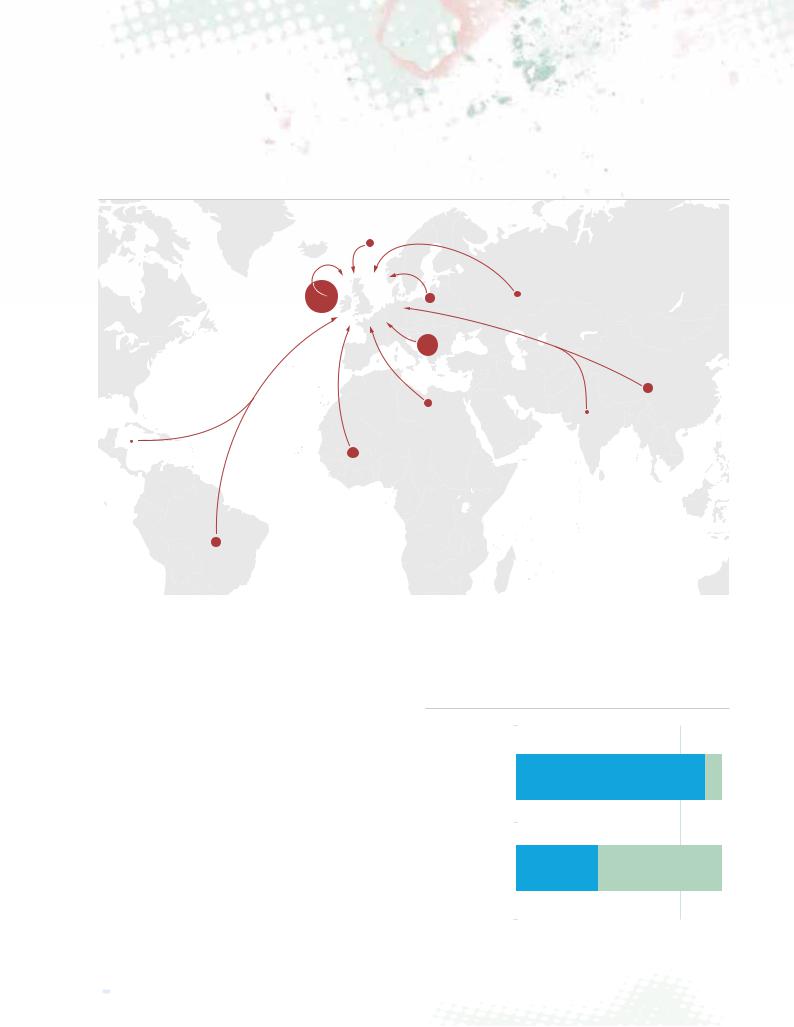
GLOBAL REPORT ON TRAFFICKING IN PERSONS 2014
MAP 7: Citizenships of convicted traffickers in Western and Central Europe, by subregion, shares of the total, 2010-2012 (or more recent)
100% is equivalent to |
|
|
Others Europe |
|
|
|
3,539 persons convicted |
|
|
|
|
||
|
|
|
(cross-border) |
|
|
|
|
Local nationals |
|
3% |
1.5% |
|
|
|
51% |
|
|
|
||
|
|
|
|
Central Europe |
|
|
|
|
|
Western |
4% (cross-border) |
Eastern Europe |
|
|
|
and Central |
|
|||
|
|
|
and Central Asia |
|||
|
|
|
Europe |
|
|
|
|
|
|
|
|
|
|
|
|
|
|
22% |
5% |
|
|
|
|
|
|
|
|
|
6% |
3% |
|
The Balkans |
4% |
|
|
|
|
|
|
||
|
|
|
|
|
(cross-border) |
1% |
|
|
|
|
|
|
East Asia |
0.5% |
|
|
|
|
North Africa |
|
Central America |
|
|
|
|
and the Middle East |
|
and the Caribbean |
4% |
|
|
|
|
South Asia |
West Africa
South
America
Source: UNODC.


 Sciences Po - Atelier de cartographie, 2014
Sciences Po - Atelier de cartographie, 2014
nificant share, with 2 per cent of the total. The citizenship profiles of the foreign offenders broadly mirror the profiles of the detected foreign trafficking victims, at least by major regional aggregations. A statistical analysis presented in the section Traffickers, organized crime and the business of exploitation indicated that there is a quantitative relation between the citizenships of offenders and victims detected in Western and Central Europe, when foreigners are considered in both categories. The same result was found in other destinations of trafficking in persons and confirmed by a qualitative analysis of the court cases submitted by Member States.38
The global findings show that areas that are more typical origins for cross-border trafficking in persons tend to have vastly different offender profiles than areas that are more typical destinations. As Western and Central Europe is a subregion that encompasses countries of origin as well as destination of cross-border trafficking, this is true also
38For more information on the court cases, please refer to the section on Methodology.
FIG. 31: Distribution of national and foreign offenders among countries of origin and destination of crossborder trafficking in Western and Central Europe, 2010-2012
Central Europe |
|
|
|
|
|
|
|
|
|
|
and the Balkans |
|
|
|
|
|
|
|
92% 8 |
% |
|
|
|
|
|
|
|
|
|
|||
Western and |
|
|
|
|
|
|
|
|
|
|
Southern Europe |
|
|
40% |
|
|
|
60% |
|
||
|
|
|
|
|
|
|
||||
|
|
|
|
|
|
|
|
|
|
|
0% |
20% |
40% |
60% |
80% |
100% |
|||||
 National offenders
National offenders
 Foreign offenders
Foreign offenders
Source: UNODC elaboration on national data.
60
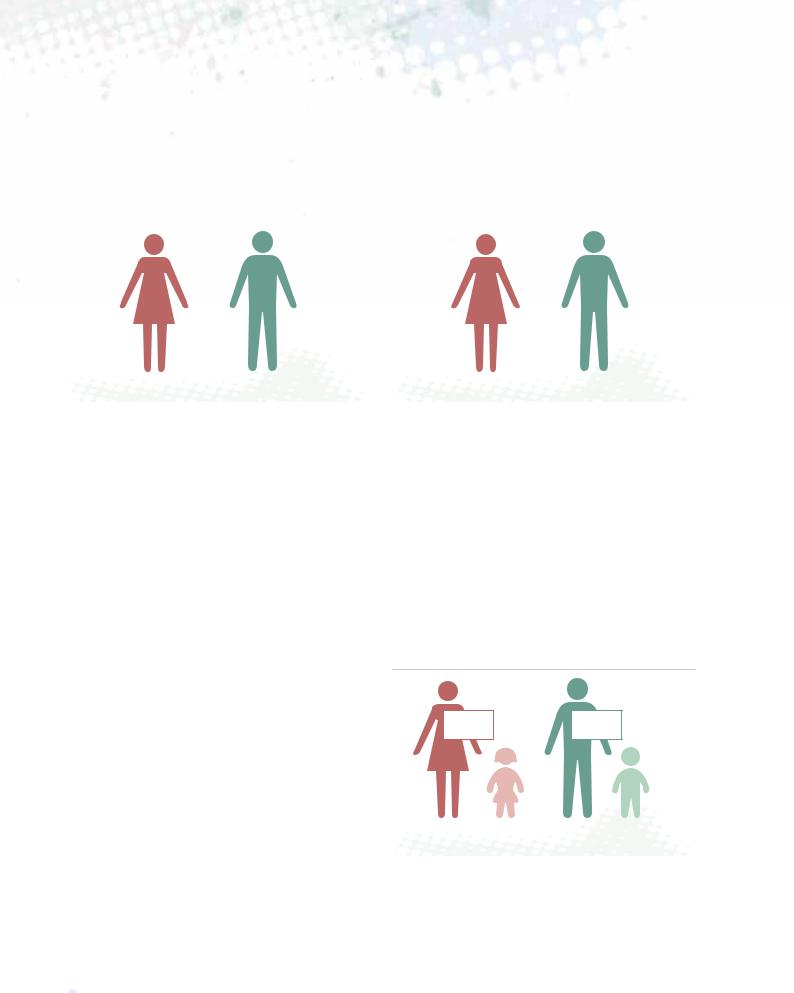
|
|
Regional overviews |
II |
|
FIG. 32: Prosecutions for trafficking in per- |
|
FIG. 33: Convictions for trafficking in persons |
|
|
sons in Western and Central Europe, |
|
in Western and Central Europe, by |
|
|
by gender, 2010-2012 (or more recent) |
|
gender, 2010-2012 (or more recent) |
|
|
|
|
|
|
|
23% |
|
77% |
|
22% |
|
78% |
Source: UNODC elaboration on national data. |
Source: UNODC elaboration on national data. |
there. Countries in the Balkans and Central Europe39 are mainly origin areas (with most victims trafficked to Western Europe) and thus convict largely local citizens. More than 9 in 10 convicted traffickers in these areas are own citizens. Countries in Western and Southern Europe - mainly countries of destination - convict large shares of foreigners, approximately 60 per cent. Almost all - about 97 per cent - of the foreigners who were convicted of trafficking in persons in Western and Central Europe were detected in the more typical destination countries of crossborder trafficking.
In terms of the gender of the offenders, countries in Western and Central Europe prosecute and convict somewhat fewer women than the global average. Some 23 per cent of those prosecuted and/or convicted of trafficking in persons in this subregion are women, compared to some 28 per cent at the global level.
Countries within the subregion report significant differences in the shares of women who are prosecuted and convicted. Some countries, for example in the Balkans, have very low shares of convictions of women. In other countries, including in the Baltic area, women comprise nearly one third of the convicted trafficking offenders.
Profile of the victims
On average, countries in Western and Central Europe detect more adult victims and more women victims than other (sub)regions. A majority of the detected victims of trafficking in persons in Western and Central Europe – some 63 per cent - are adult women, whereas the second largest group is adult men, who account for 19 per cent
39For this analysis, 15 countries that are more typical origin than destination countries for cross-border trafficking have been considered.
of the total number or victims. Adult victims thus comprise more than 80 per cent of all detected victims in this subregion.
The detection of child trafficking in Western and Central Europe is not as common as in other regions. Children account for almost 20 per cent of the detected victims, whereas globally, this group makes up nearly one third of victims. Girls are much more frequently detected than boys. Out of every five children trafficked in Western and Central Europe, four are girls and one is a boy.
FIG. 34: Gender and age profiles of victims detected in Western and Central Europe, 2010-2012 (or more recent)
62% 19%
16% |
|
3% |
Source: UNODC elaboration on national data.
Most of the detected victims in this subregion – approximately 65 per cent - were subjected to sexual exploitation. This seems to be connected to the high share of females among the total number of detected victims since trafficking for sexual exploitation largely affects women. Trafficking for sexual exploitation does not only affect females, however. Some 4 per cent of the victims of this type of trafficking were males in Western and Central Europe during the 2010 – 2012 period.
61
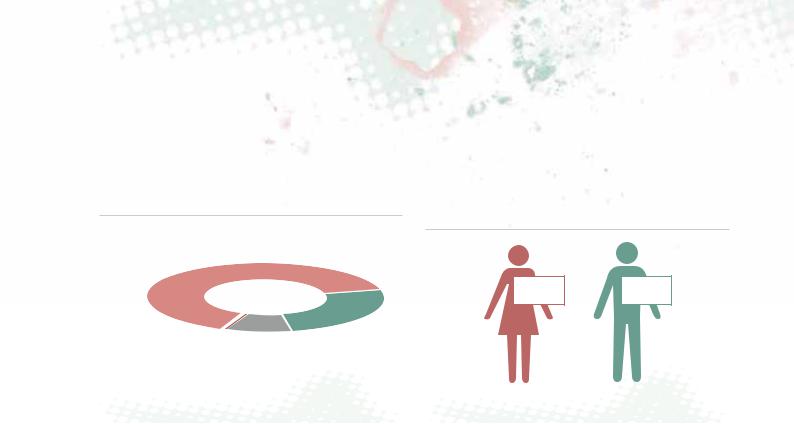
GLOBAL REPORT ON TRAFFICKING IN PERSONS 2014
FIG. 35: Forms of exploitation detected in Western and Central Europe,
2010-2012 (or more recent)
SEXUAL EXPLOITATION
65%
ORGAN |
|
FORCED |
REMOVAL |
OTHERS |
LABOUR |
0.1% |
9% |
26% |
Source: UNODC elaboration on national data.
FIG. 36: Gender breakdown of victims trafficked for forced labour in Western and Central Europe,
2010-2012 (or more recent)
31% 69%
Source: UNODC elaboration on national data.
The large share of victims trafficked for sexual exploitation implies that forced labour is less commonly detected in this subregion. 25 per cent of the victims detected in Western and Central Europe were exploited in forced labour. About 30 per cent of these victims were females, while about 70 per cent were males.
In Western and Central Europe, victims exploited in ‘other’ forms of trafficking are relatively frequently detected. Some 9 per cent of victims were trafficked for purposes other than sexual exploitation or forced labour. For instance, about 1.5 per cent of the detected victims were trafficked for begging, while more than 1 per cent were trafficked for the purpose of committing (often petty) crime. Other types of exploitation in this category include forced marriages, welfare fraud, children exploited for the production of pornographic material, as well as mixed sexual and labour exploitation.
As far as the gender distribution for trafficking for ‘other’ purposes is concerned, for victims detected in Western and Central Europe between 2010 and 2012, female victims account for some 72 per cent of the victims of this type of trafficking.
Trafficking flows
The most striking feature of trafficking in persons in Western and Central Europe is the diversity of trafficking flows associated with this subregion. As mentioned before, it is a significant origin and destination area simultaneously. From an origin point of view, victims from this subregion are largely trafficked within the subregion, mainly from Central Europe and the Balkans towards the other countries, and in terms of domestic trafficking.
As a destination area, Western and Central European countries detected victims of more than 130 different citizenships, displaying a vast variety of trafficking flows directed to this part of the world. The victims detected here between 2010 and 2012 were mainly from within the subregion, but also from a broad range of other countries. In other words, while the subregional nature of trafficking in persons is the key feature, at the same time, Western and Central Europe is also a significant destination area for victims from elsewhere.
Cross-border trafficking originating from within the subregion accounts for the largest share of detected victims, nearly 40 per cent. Victims from approximately 40 Western and Central European countries have been detected in the subregion. The vast majority of these victims come from countries in the Balkans. Victims from the Balkan area have been identified in significant numbers in all parts of Western and Central Europe.
Domestic trafficking accounts for about one fourth of the total number of victims detected in Western and Central Europe. Added up, the shares of subregional cross-border trafficking and domestic trafficking show that more than six in 10 victims detected in Western and Central Europe are citizens of countries within the subregion.
However, the trafficking flows are different when focusing on different areas within the subregion. When the analysis considers the more affluent countries in Western and Southern Europe, domestic trafficking accounts for 16 per cent of the total number of detected victims, while for countries in Central Europe and the Balkans, it accounts for about 80 per cent of the detected victims.
62

Regional overviews |
II |
MAP 8: Origins of victims trafficked to Western and Central Europe, by subregion, share of the total number of victims detected there, 2010-2012
100% is equivalent to
16,718 detected victims
 within Western and Central Europe
within Western and Central Europe 
 62%
62%
Americas
Source: UNODC.
|
4% |
|
Western |
|
|
and Central |
Eastern Europe |
|
Europe |
||
and Central Asia |
||
|
||
8% |
7% |
|
|
 19%
19%
South Asia, East Asia and the Pacific
Africa and
the Middle East
Sciences Po - Atelier de cartographie, 2014

MAP 9: Origins of victims trafficked to Western and Southern Europe, share of the total number of victims detected there, 2010-2012 (or more recent)
100% is equivalent to
14,775 detected victims
|
|
Other Europe |
|
|
|
Percentages are written |
|
(cross-border) |
|
|
|
Domestic |
|
|
|
|
|
for values above 3% |
|
|
|
|
|
16% |
4% |
|
|
|
|
|
|
|
|
||
|
|
13% |
Central Europe |
Eastern Europe |
|
|
|
|
|
||
|
|
|
|
|
|
|
|
Western |
7% |
|
and Central Asia |
and Southern
|
Europe |
27% |
|
7% |
|
|
|
|
The Balkans |
|
|
|
|
|
|
|
16% |
|
|
|
|
North Africa |
East Asia |
|
|
|
|
|
|
and the Middle East |
South Asia |
|
|
|
|
Central America |
|
|
|
and the Caribbean |
|
|
|
|
West Africa |
|
|
|
|
Other |
|
|
|
Sub-Saharan Africa |
|
South |
|
|
|
America |
|
|
|
Sciences Po - Atelier de cartographie, 2014
Source: UNODC.
63

GLOBAL REPORT ON TRAFFICKING IN PERSONS 2014
MAP 10: Origins of victims trafficked to Central Europe and the Balkans, share of the total number of victims detected there, 2010-2012 (or more recent)
100% is equivalent to |
|
|
2014 |
1,943 detected victims |
|
|
cartographie, |
Percentages are written |
Central Europe |
|
|
Other |
|
|
|
Europe |
(cross-border) |
|
|
for values above 3% |
|
|
de |
Domestic |
5% |
|
Atelier |
|
|
||
79% |
Eastern Europe |
Po - |
|
|
Central |
and Central Asia |
|
|
Europe and |
Sciences |
|
|
The Balkans |
||
|
the Balkans |
||
|
|
|
|
|
|
(cross-border) |
|
|
|
9% |
|
|
|
|
South Asia, East Asia |
|
|
|
and the Pacific |
Americas
Sub-Saharan Africa
Source: UNODC.
MAP 11: Destinations of trafficking victims from Central Europe and the Balkans, as a proportion of the total number of victims detected at specific destinations, 2010-2012
|
|
|
|
|
40% |
|
|||
Western |
Central Europe |
|||
and Southern |
||||
and the Balkans |
||||
Europe |
||||
|
||||
5% North America, Central America 

and the Caribbean












 Sciences Po - Atelier de cartographie, 2014
Sciences Po - Atelier de cartographie, 2014
Source: UNODC.
As for cross-border trafficking from within the subregion, countries in Central Europe and the Balkans mainly receive trafficking victims from neighbouring countries of the same area, as well as victims from proximate countries in Eastern Europe. The more affluent countries in Western and Southern Europe report significant inflows from the Balkans (27 per cent) and from Central Europe (13 per cent).
Trafficking from the Balkans into the rest of the subregion remains very significant. It is, however, limited to Europe as detections of victims from the Balkans outside Europe are rare. Trafficking victims originating from Central Europe have been increasingly detected in the rest of Europe compared to the period 2007-2010. In addition, and as opposed to the victims from the Balkans, citizens of countries in this area have been detected outside Europe, particularly in North and Central America and the Caribbean. It is thus a trafficking flow that should be monitored in the future.
Moreover, more than 2 per cent of the detected victims in Western and Central Europe were trafficked from one of the Baltic countries. This is a small share, but considering the limited population of these countries, it is nonetheless significant.
Trafficking from countries in the other European subre-
64
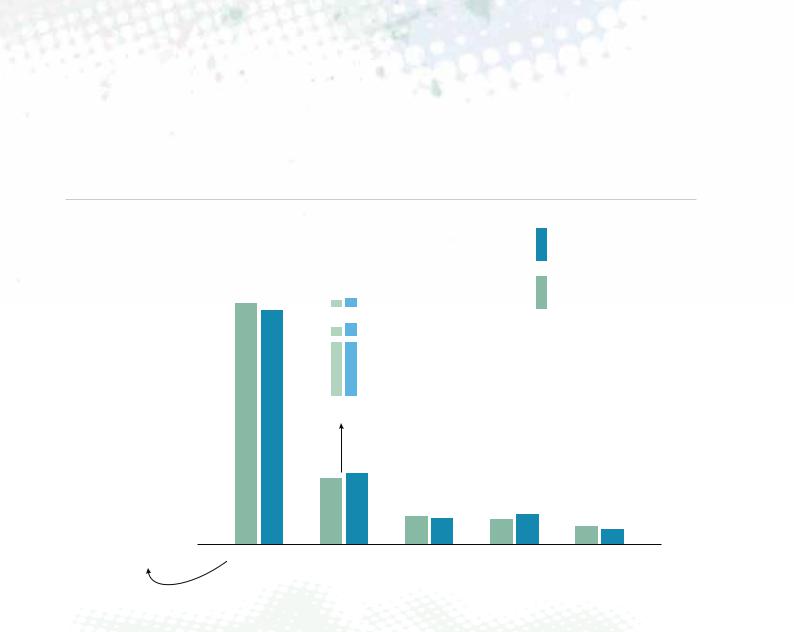
Regional overviews |
II |
FIG. 37: Evolution of the origins of trafficking into Western and Central Europe,
2007/2010-2010/2012
Other
Europe
Central
Europe
domestic trafficking
The Balkans
2% |
1% |
|
|
|
|
|
|
12% |
7% |
|
|
|
|
|
26% |
|
24% |
|
|
|
29% |
|
25% |
|
|
|
detail
|
|
|
|
|
|
|
|
2010-2012 |
|
|
|
|
|
|
|
|
|
|
100% is equivalent to |
|
|
|
|
|
|
|
|
|
|
16,718 detected victims |
|
|
|
2% |
2% |
North Africa |
|
|
|
2007-2010 |
|
|
|
|
|
|
|
100% is equivalent to |
|
|||||
|
2% |
3% |
and Middle East |
|
|
16,808 detected victims |
|
|||
|
Sub-Saharan |
|
|
|
|
|
|
|||
|
|
|
Africa, other |
|
|
|
|
|
|
|
|
14% |
14% |
West Africa |
|
|
|
|
|
|
|
|
detail |
|
|
|
|
|
|
|
2014 |
|
|
|
|
|
|
|
|
|
Sciences Po - Atelier de cartographie, |
||
64% 62% |
18% 19% |
7% |
7% |
7% |
8% |
5% |
4% |
|||
within Western |
Africa and |
East and |
Americas |
Eastern Europe |
|
|||||
and Central |
the Middle |
South Asia |
|
|
and Central Asia |
|
||||
Europe |
East |
|
|
|
|
|
|
|
|
|
Source: UNODC elaboration on national data.
gion, Eastern Europe and Central Asia, into Western and Central Europe, accounts for about 4 per cent of the total number of detected victims, which is a very similar value to what was reported for the 2007-2010 period in the
Global Report on Trafficking in Persons 2012 (almost 5 per cent).
Although subregional trafficking is more prominently detected, the share of victims who are trafficked transregionally to Western and Central Europe is almost 40 per cent. This share reaches peaks of 50 per cent in the countries of Western and Southern Europe, while such trafficking is marginal for the countries in Central Europe and the Balkans. The dispersion of these victims’ origin countries is remarkable. Victims with some 80 non-Euro- pean citizenships were detected across Western and Central Europe between 2010 and 2012. This subregion is clearly one of the main destinations for transregional trafficking. Other wealthy areas also receive a lot of inbound cross-border trafficking, but that tends to come from countries that are relatively close in geographical terms.
Western and Central Europe is the only region to detect victims from every other region in significant numbers.
Looking specifically at the origins of transregional trafficking flows, the trafficking of Africans, particularly West Africans, appears to be the most significant. Detections of West Africans are second only to that of people from the Balkans in terms of shares of the total number of victims who are trafficked cross-border. West African victims have been detected in 20 countries across most of Western and Central Europe. The relevance and endurance of this trafficking flow across many parts of Western and Central Europe might indicate the presence of a well-organized structure behind the flow.
Trafficking from other parts of Sub-Saharan Africa is also detected. Moreover, victims from North African countries - especially from the Maghreb - are broadly dispersed. These victims are detected in limited numbers but in different countries.
The detection of victims from the Americas used to be
65
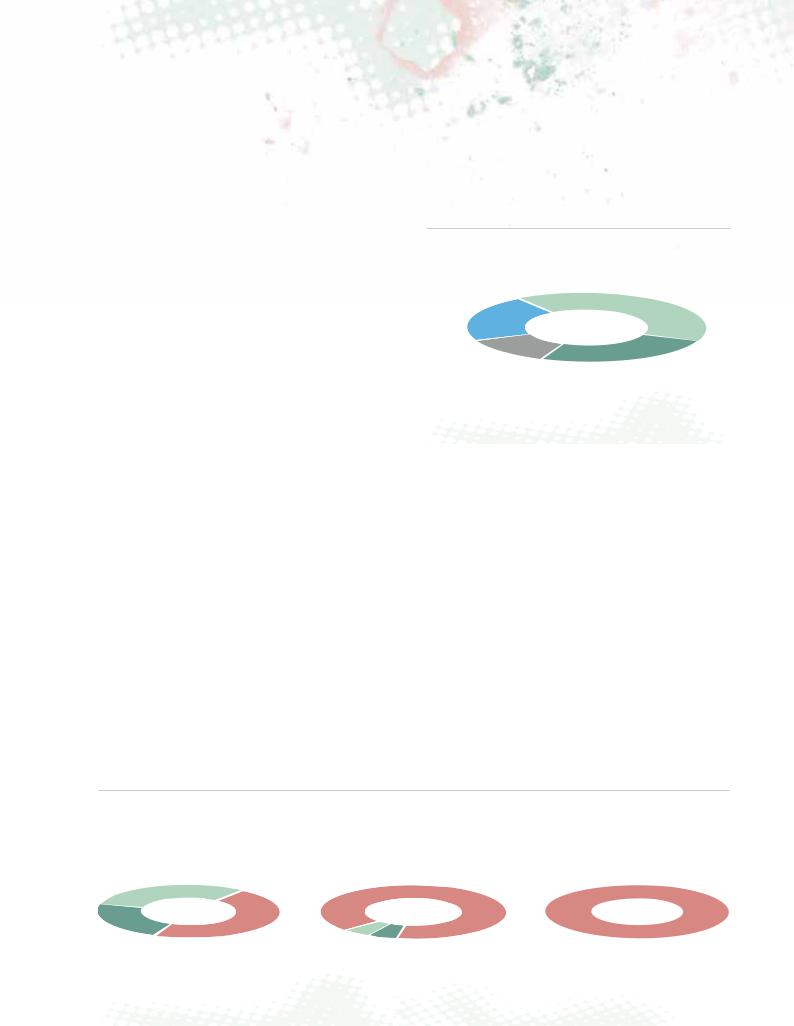
GLOBAL REPORT ON TRAFFICKING IN PERSONS 2014
largely limited to Spain and Portugal. This has changed, and nowadays, victims from the Americas – primarily South America, and to a lesser extent, Central America and the Caribbean - have been detected in other countries of this subregion. During the 2010-2012 period, South American victims accounted for 6 per cent of the total number of victims detected in Western and Central Europe.
Victims from the Caribbean accounted for approximately 1.5 per cent of the total number of detected victims in some 9 countries in Western and Central Europe. This is quite a remarkable share for relatively small and distant countries.
Asian victims are also detected in significant numbers in Western and Central Europe. This group accounts for about 6 per cent of the total number of detected victims. East and South-East Asian victims have been detected in many countries. Additionally, South Asian victims have been detected in many countries in Western and Central Europe, but in limited numbers.
Response to trafficking in persons
In terms of legislation, all the countries in Western and Central Europe considered in this Report have national legislation that is in line with the UN Trafficking in Persons Protocol today. The historical evolution of the legislation in this part of the world was, to a considerable extent, affected by the entry into force of the Protocol in December 2003. More than half of the countries amended their criminal code after this date to introduce a specific offence on trafficking in persons that was in line with the international standards.
FIG. 39: Number of Western and Central European countries according to the number of convictions per year reported, 2010-2012
TOTAL NUMBER OF COUNTRIES |
BETWEEN 10 AND 50 |
|
CONSIDERED, N:32 |
CONVICTIONS PER YEAR |
|
|
||
LESS THAN TEN |
13 |
|
CONVICTIONS |
||
PER YEAR |
|
|
7 |
|
|
INFORMATION |
MORE THAN 50 |
|
NOT AVAILABLE |
||
4 |
CONVICTIONS PER YEAR |
|
8 |
||
|
Source: UNODC elaboration on national data.
While several of the countries had specific legislation before December 2003, the offences were often introduced either in the year 2002 or earlier in 2003. So for many of these countries as well, the legislation was amended as a result of the political push generated by the Trafficking in Persons Protocol that was adopted by the Member States in the year 2000.
A further geographical analysis shows that the countries in Central Europe and the Balkans were the quickest in setting up their legislative counter-trafficking framework. Among the 18 countries with proper legislation in place in 2003, 6 were in Western Europe, while 12 were in Central Europe and the Balkans. The gap was quickly closed, however, as after just five years, most of the countries had adopted proper legislation to combat trafficking in persons.
FIG. 38: Historical evolution of the legislation in Western and Central Europe, 2003-2012
TOTAL NUMBER OF COUNTRIES CONSIDERED, N:39 |
2008 |
|
2012 |
|
2003 OFFENCE |
FORMS |
FORMS |
||
PARTIAL |
|
MOST / ALL |
|
MOST / ALL |
12 |
|
35 |
|
39 |
NO OFFENCE |
MOST / ALL |
PARTIAL |
NO OFFENCE |
9 |
FORMS |
OFFENCE |
2 |
|
18 |
2 |
|
Source: UNODC elaboration on national data.
66
